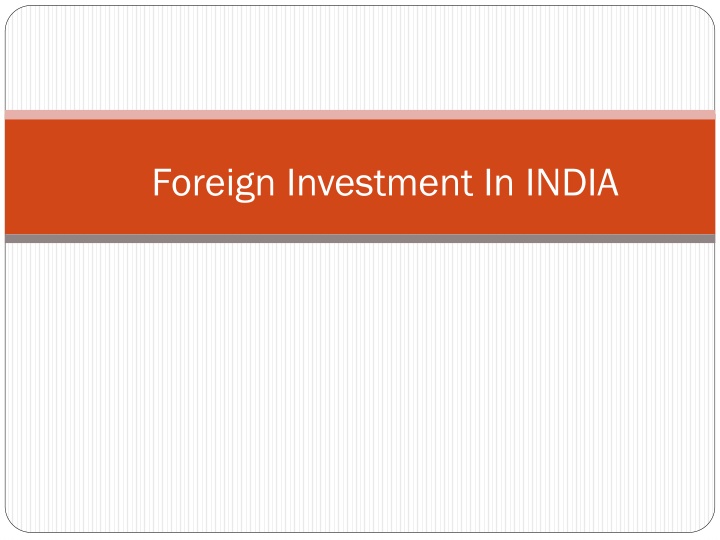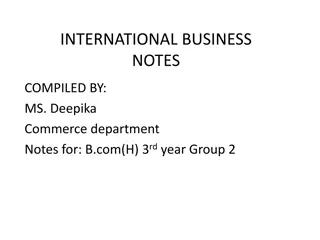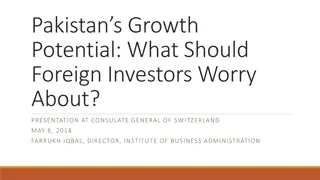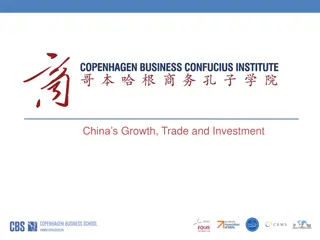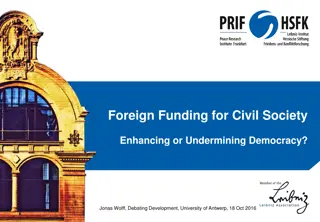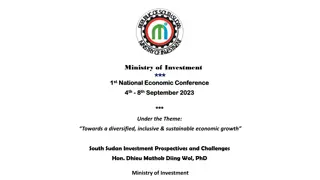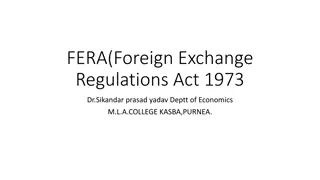Foreign Investment in India - Overview and Opportunities
Foreign Direct Investment (FDI) plays a crucial role in India's economic growth. Explore types of FDI, modes, factors affecting FDI, and why India is a favorable investment destination with its skilled workforce, market potential, and incentives.
Download Presentation

Please find below an Image/Link to download the presentation.
The content on the website is provided AS IS for your information and personal use only. It may not be sold, licensed, or shared on other websites without obtaining consent from the author.If you encounter any issues during the download, it is possible that the publisher has removed the file from their server.
You are allowed to download the files provided on this website for personal or commercial use, subject to the condition that they are used lawfully. All files are the property of their respective owners.
The content on the website is provided AS IS for your information and personal use only. It may not be sold, licensed, or shared on other websites without obtaining consent from the author.
E N D
Presentation Transcript
Foreign Direct Investment (FDI) What is FDI Why we need FDI Process of the Inflow of FDI Benefits Types Advantages and disadvantages FII Diff between FII and FDI
Modes of FDI 1) By Direction * Inward *Outward 2) By Target * Mergers and Acquisitions * Horizontal FDI * Vertical FDI (a) Backward Vertical FDI (b) Forward Vertical FDI 3 )By Motive * Resource-Seeking * Market-Seeking * Efficiency-Seeking
Factors Affecting FDI Financial incentives (Funds from local Government) Fiscal incentives (Exemption from import duties) Indirect incentives (Provides land and Political stability Market potential & accessibility Large economy Market size
Why India? Liberal, largest democracy, Political Stability Second largest emerging market (US$ 2.4 trillion) Skilled and competitive labors force highest rates of return on investment one hundred of the Fortune 500 have R & D facilities in India Second largest group of software developers after the U.S. lists 6,500 companies on the Bombay Stock Exchange (only the NYSE has more)
Why India (cont.) World's fourth largest economy & second largest pharmaceutical industry growth over the past few years averaging 8% has a middle class estimated at 300 million out of a total population of 1 billion Destination for business process outsourcing, Knowledge processing etc. Second largest English-speaking, scientific, technical and executive manpower Low costs & Tax exemptions in SEZ Tax incentives for IT , business process outsourcing and KPO companies
Government policies Automatic Route Prior Permission (FIPB)
FDI Investment Sectors Fully permitted Activities Cigar and cigarettes of tobacco Coal, Roads & Highways Diamond, Gold, Silver , Minerals Atomic minerals Electricity Hotel, hospitals Prohibited activities Atomic energy Arms and ammunition Lottery business Betting and Gambling Aircraft and warships Coal lignite
Retail I.T Oil & Energy Power sector Pharmaceuticals & Chemicals Real state Mining Mobile Sector Automobile Telecommunication FDI inflows In real estate US$ 5 Billion FDI inflows Retail US$ 20 Billion by 2010 FDI inflows in Mining US$ 2,5 Billion per N.M. FDI inflows in Telecommunication US$ 24 Billion
Major Investments Companies Sector Investment Wal mart,Marks Retail US$ 10 Billion Intel Corp. I.T US$ 40 Billion British & cairn Oil & Energy US$ 2 Billion Essar power Power sector US$ 2 Billion Toyota Automobile US$ 10.51 Billion Panasonic Telecommunicatio n US$ 200 million
What is an FII?? An institution established outside India, which invests in securities traded on the markets in India e.g. Pension Funds Mutual Funds Investment Trust Insurance companies Endowment Funds University Funds Foundations or Charitable Trusts Asset Management Companies Power of Attorney Holders Bank
FII Vs FDI FII is Foreign Institutional Investment: It is investment made by foreign Mutual Funds in the Indian Market. FDI is Foreign Direct Investment: It is the investment made by Foreign Multinational companies in India.
Foreign Institutional Investors (FII) Foreign investment banks are not permitted to directly invest in shares on the Indian stock exchange Makes investments on behalf of foreign investors, referred to as sub-accounts
Foreign Institutional Investors (FII) FIIs may invest in: securities in the primary and secondary markets (shares, debentures, warrants of listed and unlisted companies) units issued by domestic mutual funds dated Government securities derivatives traded on a recognized stock exchange commercial paper debt instruments provided a 70/30 equity/debt ratio is maintained
Foreign Institutional Investors (FII) Limits on the type and amount of investments apply to FIIs no more than 10% of the equity in any one company no more than 10% in the equity in any one company on behalf of a fund sub-account no more than 5% in the equity in any one company on behalf of a corporate/individual sub-account no more than 24% in the aggregate of the total issued capital of a company to be held by FIIs
